A Study on the Dimensions of Service Quality in Banking Sector and CS
VerifiedAdded on 2021/04/23
|31
|10264
|124
Project
AI Summary
This project investigates the critical role of service quality in the banking sector and its impact on customer satisfaction. Utilizing the SERVQUAL model, the study analyzes the dimensions of service quality, including tangibility, reliability, responsiveness, assurance, and empathy, and their effects on customer satisfaction and retention. The research explores the relationship between service quality and customer satisfaction, highlighting how banks can improve service delivery to meet and exceed customer expectations. The project also addresses the strategic importance of service quality in building customer loyalty and achieving a competitive advantage within the banking industry. The study examines the impact of both human and non-human related factors of service quality on customer satisfaction. The project provides a comprehensive literature review, a detailed introduction, and a conclusion, along with tables and figures to support the analysis. The findings of this project can support banks to recognize service quality dimensions that greatest predict customers’ satisfaction.
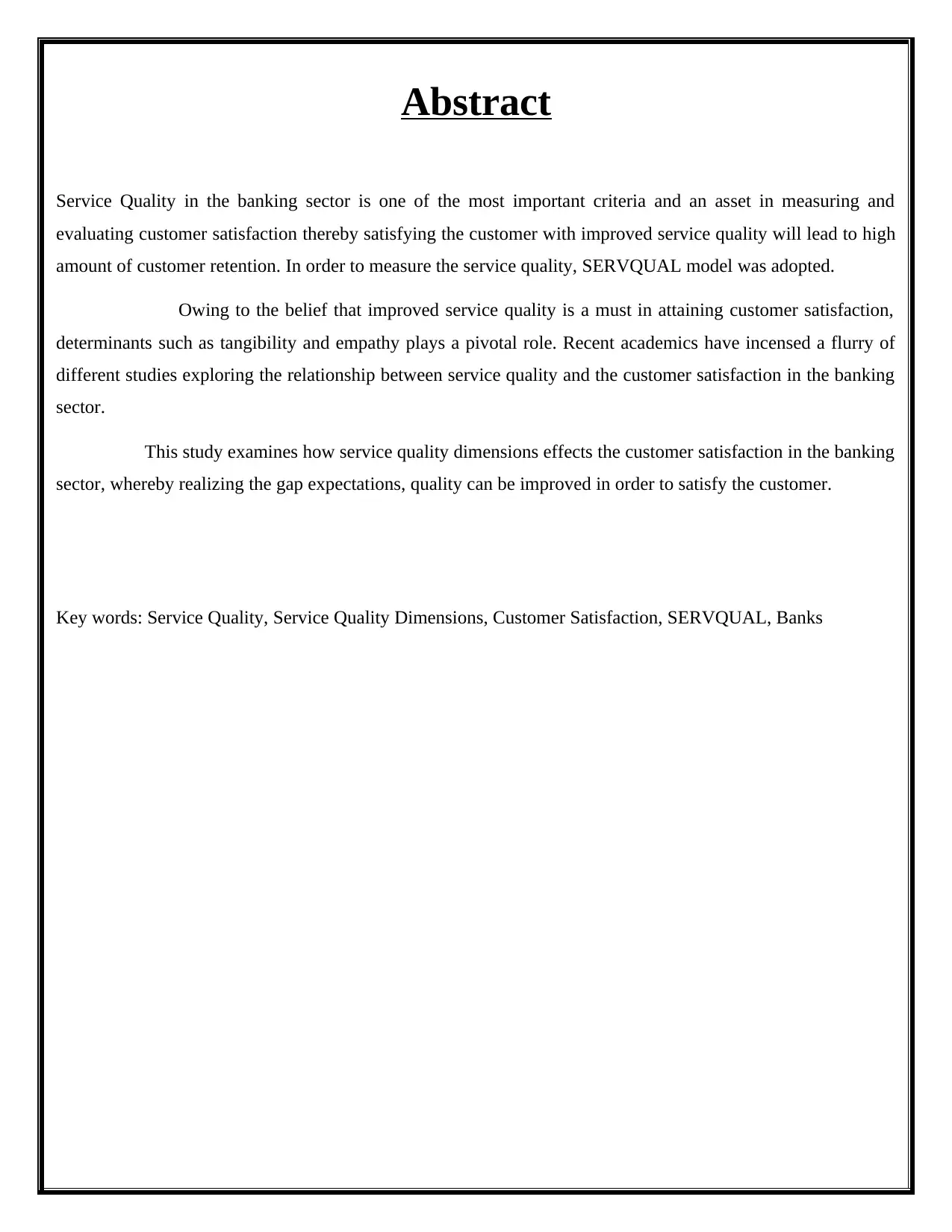
Abstract
Service Quality in the banking sector is one of the most important criteria and an asset in measuring and
evaluating customer satisfaction thereby satisfying the customer with improved service quality will lead to high
amount of customer retention. In order to measure the service quality, SERVQUAL model was adopted.
Owing to the belief that improved service quality is a must in attaining customer satisfaction,
determinants such as tangibility and empathy plays a pivotal role. Recent academics have incensed a flurry of
different studies exploring the relationship between service quality and the customer satisfaction in the banking
sector.
This study examines how service quality dimensions effects the customer satisfaction in the banking
sector, whereby realizing the gap expectations, quality can be improved in order to satisfy the customer.
Key words: Service Quality, Service Quality Dimensions, Customer Satisfaction, SERVQUAL, Banks
Service Quality in the banking sector is one of the most important criteria and an asset in measuring and
evaluating customer satisfaction thereby satisfying the customer with improved service quality will lead to high
amount of customer retention. In order to measure the service quality, SERVQUAL model was adopted.
Owing to the belief that improved service quality is a must in attaining customer satisfaction,
determinants such as tangibility and empathy plays a pivotal role. Recent academics have incensed a flurry of
different studies exploring the relationship between service quality and the customer satisfaction in the banking
sector.
This study examines how service quality dimensions effects the customer satisfaction in the banking
sector, whereby realizing the gap expectations, quality can be improved in order to satisfy the customer.
Key words: Service Quality, Service Quality Dimensions, Customer Satisfaction, SERVQUAL, Banks
Paraphrase This Document
Need a fresh take? Get an instant paraphrase of this document with our AI Paraphraser

Acknowledgement
Thank you!
Thank you!
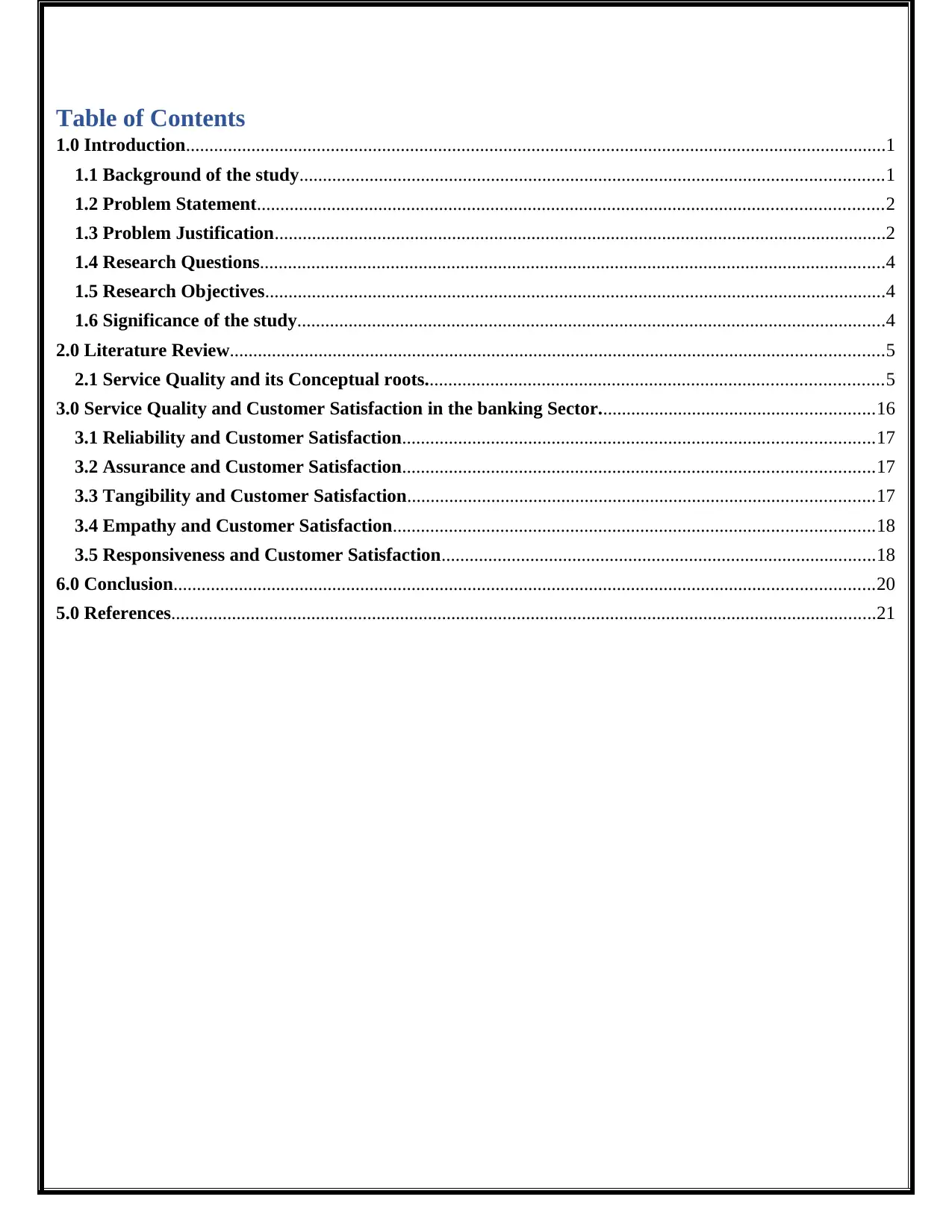
Table of Contents
1.0 Introduction......................................................................................................................................................1
1.1 Background of the study.............................................................................................................................1
1.2 Problem Statement......................................................................................................................................2
1.3 Problem Justification...................................................................................................................................2
1.4 Research Questions......................................................................................................................................4
1.5 Research Objectives.....................................................................................................................................4
1.6 Significance of the study..............................................................................................................................4
2.0 Literature Review............................................................................................................................................5
2.1 Service Quality and its Conceptual roots..................................................................................................5
3.0 Service Quality and Customer Satisfaction in the banking Sector...........................................................16
3.1 Reliability and Customer Satisfaction.....................................................................................................17
3.2 Assurance and Customer Satisfaction.....................................................................................................17
3.3 Tangibility and Customer Satisfaction....................................................................................................17
3.4 Empathy and Customer Satisfaction.......................................................................................................18
3.5 Responsiveness and Customer Satisfaction.............................................................................................18
6.0 Conclusion......................................................................................................................................................20
5.0 References.......................................................................................................................................................21
1.0 Introduction......................................................................................................................................................1
1.1 Background of the study.............................................................................................................................1
1.2 Problem Statement......................................................................................................................................2
1.3 Problem Justification...................................................................................................................................2
1.4 Research Questions......................................................................................................................................4
1.5 Research Objectives.....................................................................................................................................4
1.6 Significance of the study..............................................................................................................................4
2.0 Literature Review............................................................................................................................................5
2.1 Service Quality and its Conceptual roots..................................................................................................5
3.0 Service Quality and Customer Satisfaction in the banking Sector...........................................................16
3.1 Reliability and Customer Satisfaction.....................................................................................................17
3.2 Assurance and Customer Satisfaction.....................................................................................................17
3.3 Tangibility and Customer Satisfaction....................................................................................................17
3.4 Empathy and Customer Satisfaction.......................................................................................................18
3.5 Responsiveness and Customer Satisfaction.............................................................................................18
6.0 Conclusion......................................................................................................................................................20
5.0 References.......................................................................................................................................................21
⊘ This is a preview!⊘
Do you want full access?
Subscribe today to unlock all pages.

Trusted by 1+ million students worldwide
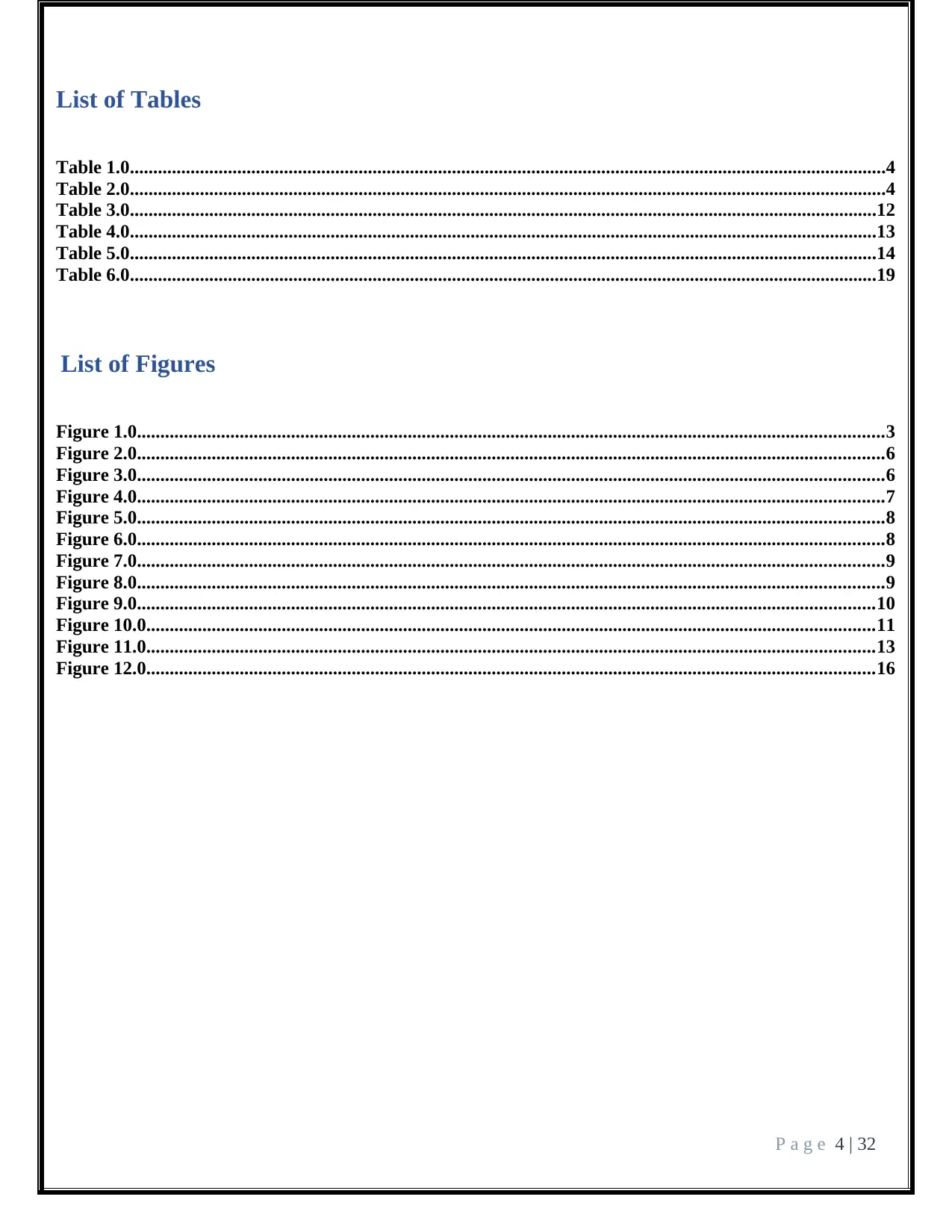
List of Tables
Table 1.0..................................................................................................................................................................4
Table 2.0..................................................................................................................................................................4
Table 3.0................................................................................................................................................................12
Table 4.0................................................................................................................................................................13
Table 5.0................................................................................................................................................................14
Table 6.0................................................................................................................................................................19
List of Figures
Figure 1.0................................................................................................................................................................3
Figure 2.0................................................................................................................................................................6
Figure 3.0................................................................................................................................................................6
Figure 4.0................................................................................................................................................................7
Figure 5.0................................................................................................................................................................8
Figure 6.0................................................................................................................................................................8
Figure 7.0................................................................................................................................................................9
Figure 8.0................................................................................................................................................................9
Figure 9.0..............................................................................................................................................................10
Figure 10.0............................................................................................................................................................11
Figure 11.0............................................................................................................................................................13
Figure 12.0............................................................................................................................................................16
P a g e 4 | 32
Table 1.0..................................................................................................................................................................4
Table 2.0..................................................................................................................................................................4
Table 3.0................................................................................................................................................................12
Table 4.0................................................................................................................................................................13
Table 5.0................................................................................................................................................................14
Table 6.0................................................................................................................................................................19
List of Figures
Figure 1.0................................................................................................................................................................3
Figure 2.0................................................................................................................................................................6
Figure 3.0................................................................................................................................................................6
Figure 4.0................................................................................................................................................................7
Figure 5.0................................................................................................................................................................8
Figure 6.0................................................................................................................................................................8
Figure 7.0................................................................................................................................................................9
Figure 8.0................................................................................................................................................................9
Figure 9.0..............................................................................................................................................................10
Figure 10.0............................................................................................................................................................11
Figure 11.0............................................................................................................................................................13
Figure 12.0............................................................................................................................................................16
P a g e 4 | 32
Paraphrase This Document
Need a fresh take? Get an instant paraphrase of this document with our AI Paraphraser
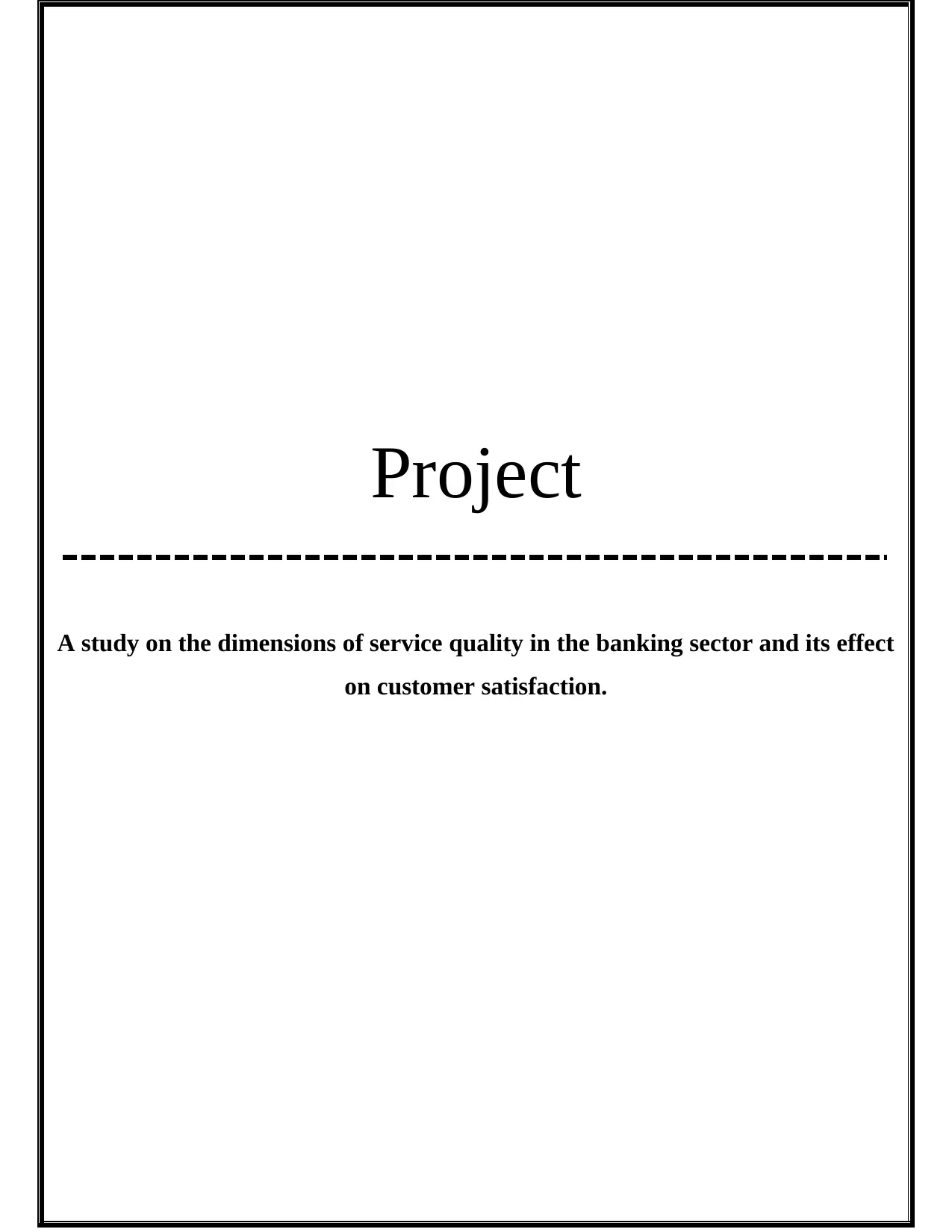
Project
A study on the dimensions of service quality in the banking sector and its effect
on customer satisfaction.
A study on the dimensions of service quality in the banking sector and its effect
on customer satisfaction.
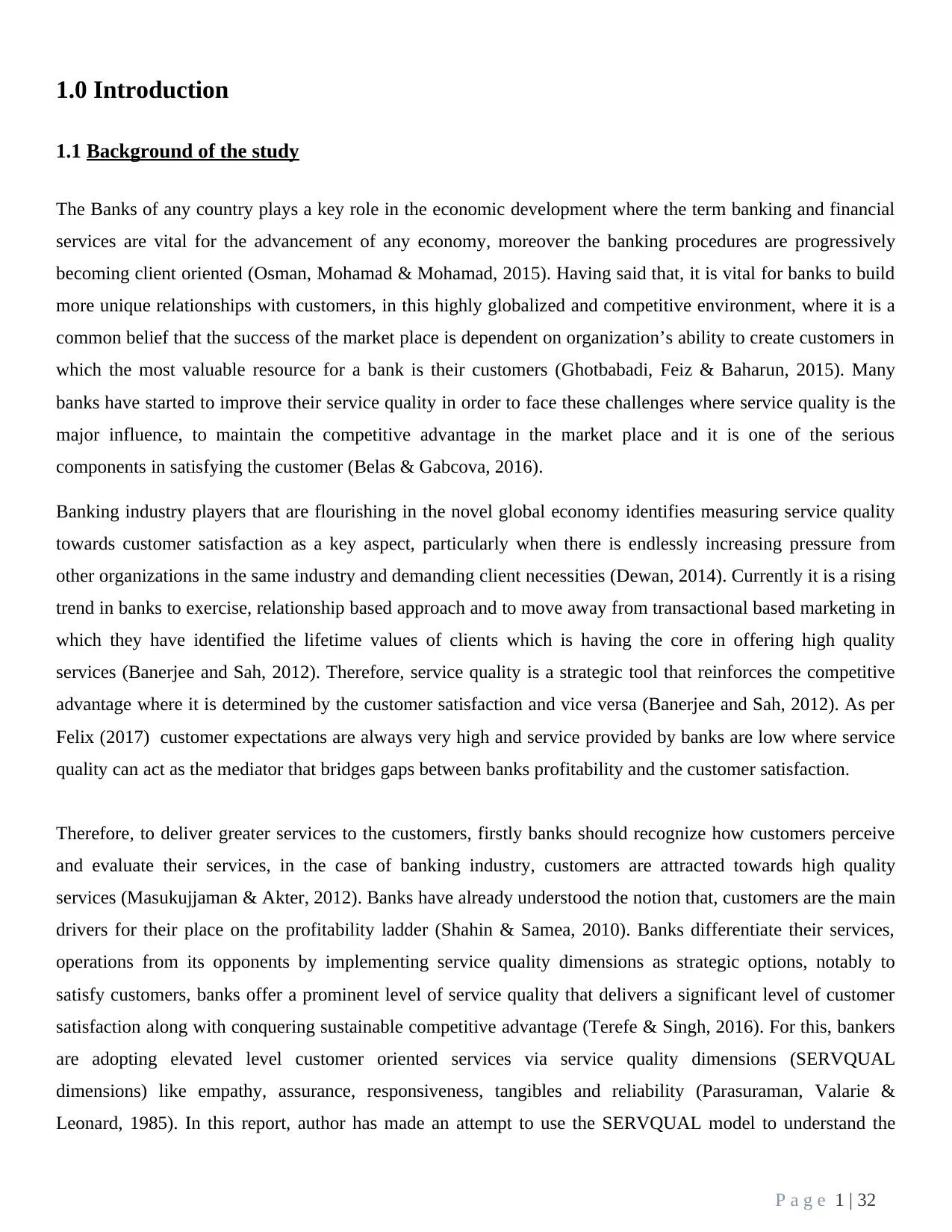
1.0 Introduction
1.1 Background of the study
The Banks of any country plays a key role in the economic development where the term banking and financial
services are vital for the advancement of any economy, moreover the banking procedures are progressively
becoming client oriented (Osman, Mohamad & Mohamad, 2015). Having said that, it is vital for banks to build
more unique relationships with customers, in this highly globalized and competitive environment, where it is a
common belief that the success of the market place is dependent on organization’s ability to create customers in
which the most valuable resource for a bank is their customers (Ghotbabadi, Feiz & Baharun, 2015). Many
banks have started to improve their service quality in order to face these challenges where service quality is the
major influence, to maintain the competitive advantage in the market place and it is one of the serious
components in satisfying the customer (Belas & Gabcova, 2016).
Banking industry players that are flourishing in the novel global economy identifies measuring service quality
towards customer satisfaction as a key aspect, particularly when there is endlessly increasing pressure from
other organizations in the same industry and demanding client necessities (Dewan, 2014). Currently it is a rising
trend in banks to exercise, relationship based approach and to move away from transactional based marketing in
which they have identified the lifetime values of clients which is having the core in offering high quality
services (Banerjee and Sah, 2012). Therefore, service quality is a strategic tool that reinforces the competitive
advantage where it is determined by the customer satisfaction and vice versa (Banerjee and Sah, 2012). As per
Felix (2017) customer expectations are always very high and service provided by banks are low where service
quality can act as the mediator that bridges gaps between banks profitability and the customer satisfaction.
Therefore, to deliver greater services to the customers, firstly banks should recognize how customers perceive
and evaluate their services, in the case of banking industry, customers are attracted towards high quality
services (Masukujjaman & Akter, 2012). Banks have already understood the notion that, customers are the main
drivers for their place on the profitability ladder (Shahin & Samea, 2010). Banks differentiate their services,
operations from its opponents by implementing service quality dimensions as strategic options, notably to
satisfy customers, banks offer a prominent level of service quality that delivers a significant level of customer
satisfaction along with conquering sustainable competitive advantage (Terefe & Singh, 2016). For this, bankers
are adopting elevated level customer oriented services via service quality dimensions (SERVQUAL
dimensions) like empathy, assurance, responsiveness, tangibles and reliability (Parasuraman, Valarie &
Leonard, 1985). In this report, author has made an attempt to use the SERVQUAL model to understand the
P a g e 1 | 32
1.1 Background of the study
The Banks of any country plays a key role in the economic development where the term banking and financial
services are vital for the advancement of any economy, moreover the banking procedures are progressively
becoming client oriented (Osman, Mohamad & Mohamad, 2015). Having said that, it is vital for banks to build
more unique relationships with customers, in this highly globalized and competitive environment, where it is a
common belief that the success of the market place is dependent on organization’s ability to create customers in
which the most valuable resource for a bank is their customers (Ghotbabadi, Feiz & Baharun, 2015). Many
banks have started to improve their service quality in order to face these challenges where service quality is the
major influence, to maintain the competitive advantage in the market place and it is one of the serious
components in satisfying the customer (Belas & Gabcova, 2016).
Banking industry players that are flourishing in the novel global economy identifies measuring service quality
towards customer satisfaction as a key aspect, particularly when there is endlessly increasing pressure from
other organizations in the same industry and demanding client necessities (Dewan, 2014). Currently it is a rising
trend in banks to exercise, relationship based approach and to move away from transactional based marketing in
which they have identified the lifetime values of clients which is having the core in offering high quality
services (Banerjee and Sah, 2012). Therefore, service quality is a strategic tool that reinforces the competitive
advantage where it is determined by the customer satisfaction and vice versa (Banerjee and Sah, 2012). As per
Felix (2017) customer expectations are always very high and service provided by banks are low where service
quality can act as the mediator that bridges gaps between banks profitability and the customer satisfaction.
Therefore, to deliver greater services to the customers, firstly banks should recognize how customers perceive
and evaluate their services, in the case of banking industry, customers are attracted towards high quality
services (Masukujjaman & Akter, 2012). Banks have already understood the notion that, customers are the main
drivers for their place on the profitability ladder (Shahin & Samea, 2010). Banks differentiate their services,
operations from its opponents by implementing service quality dimensions as strategic options, notably to
satisfy customers, banks offer a prominent level of service quality that delivers a significant level of customer
satisfaction along with conquering sustainable competitive advantage (Terefe & Singh, 2016). For this, bankers
are adopting elevated level customer oriented services via service quality dimensions (SERVQUAL
dimensions) like empathy, assurance, responsiveness, tangibles and reliability (Parasuraman, Valarie &
Leonard, 1985). In this report, author has made an attempt to use the SERVQUAL model to understand the
P a g e 1 | 32
⊘ This is a preview!⊘
Do you want full access?
Subscribe today to unlock all pages.

Trusted by 1+ million students worldwide
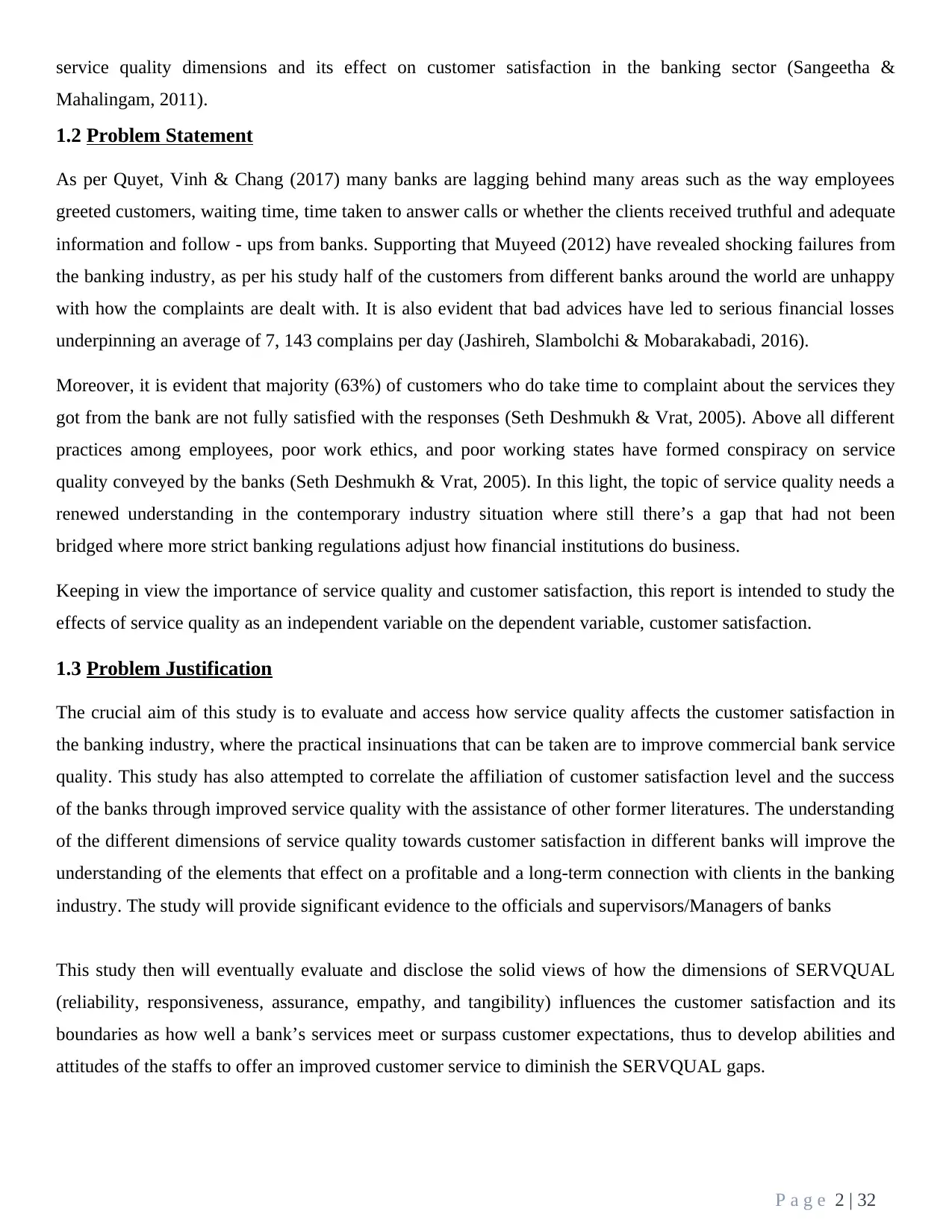
service quality dimensions and its effect on customer satisfaction in the banking sector (Sangeetha &
Mahalingam, 2011).
1.2 Problem Statement
As per Quyet, Vinh & Chang (2017) many banks are lagging behind many areas such as the way employees
greeted customers, waiting time, time taken to answer calls or whether the clients received truthful and adequate
information and follow - ups from banks. Supporting that Muyeed (2012) have revealed shocking failures from
the banking industry, as per his study half of the customers from different banks around the world are unhappy
with how the complaints are dealt with. It is also evident that bad advices have led to serious financial losses
underpinning an average of 7, 143 complains per day (Jashireh, Slambolchi & Mobarakabadi, 2016).
Moreover, it is evident that majority (63%) of customers who do take time to complaint about the services they
got from the bank are not fully satisfied with the responses (Seth Deshmukh & Vrat, 2005). Above all different
practices among employees, poor work ethics, and poor working states have formed conspiracy on service
quality conveyed by the banks (Seth Deshmukh & Vrat, 2005). In this light, the topic of service quality needs a
renewed understanding in the contemporary industry situation where still there’s a gap that had not been
bridged where more strict banking regulations adjust how financial institutions do business.
Keeping in view the importance of service quality and customer satisfaction, this report is intended to study the
effects of service quality as an independent variable on the dependent variable, customer satisfaction.
1.3 Problem Justification
The crucial aim of this study is to evaluate and access how service quality affects the customer satisfaction in
the banking industry, where the practical insinuations that can be taken are to improve commercial bank service
quality. This study has also attempted to correlate the affiliation of customer satisfaction level and the success
of the banks through improved service quality with the assistance of other former literatures. The understanding
of the different dimensions of service quality towards customer satisfaction in different banks will improve the
understanding of the elements that effect on a profitable and a long-term connection with clients in the banking
industry. The study will provide significant evidence to the officials and supervisors/Managers of banks
This study then will eventually evaluate and disclose the solid views of how the dimensions of SERVQUAL
(reliability, responsiveness, assurance, empathy, and tangibility) influences the customer satisfaction and its
boundaries as how well a bank’s services meet or surpass customer expectations, thus to develop abilities and
attitudes of the staffs to offer an improved customer service to diminish the SERVQUAL gaps.
P a g e 2 | 32
Mahalingam, 2011).
1.2 Problem Statement
As per Quyet, Vinh & Chang (2017) many banks are lagging behind many areas such as the way employees
greeted customers, waiting time, time taken to answer calls or whether the clients received truthful and adequate
information and follow - ups from banks. Supporting that Muyeed (2012) have revealed shocking failures from
the banking industry, as per his study half of the customers from different banks around the world are unhappy
with how the complaints are dealt with. It is also evident that bad advices have led to serious financial losses
underpinning an average of 7, 143 complains per day (Jashireh, Slambolchi & Mobarakabadi, 2016).
Moreover, it is evident that majority (63%) of customers who do take time to complaint about the services they
got from the bank are not fully satisfied with the responses (Seth Deshmukh & Vrat, 2005). Above all different
practices among employees, poor work ethics, and poor working states have formed conspiracy on service
quality conveyed by the banks (Seth Deshmukh & Vrat, 2005). In this light, the topic of service quality needs a
renewed understanding in the contemporary industry situation where still there’s a gap that had not been
bridged where more strict banking regulations adjust how financial institutions do business.
Keeping in view the importance of service quality and customer satisfaction, this report is intended to study the
effects of service quality as an independent variable on the dependent variable, customer satisfaction.
1.3 Problem Justification
The crucial aim of this study is to evaluate and access how service quality affects the customer satisfaction in
the banking industry, where the practical insinuations that can be taken are to improve commercial bank service
quality. This study has also attempted to correlate the affiliation of customer satisfaction level and the success
of the banks through improved service quality with the assistance of other former literatures. The understanding
of the different dimensions of service quality towards customer satisfaction in different banks will improve the
understanding of the elements that effect on a profitable and a long-term connection with clients in the banking
industry. The study will provide significant evidence to the officials and supervisors/Managers of banks
This study then will eventually evaluate and disclose the solid views of how the dimensions of SERVQUAL
(reliability, responsiveness, assurance, empathy, and tangibility) influences the customer satisfaction and its
boundaries as how well a bank’s services meet or surpass customer expectations, thus to develop abilities and
attitudes of the staffs to offer an improved customer service to diminish the SERVQUAL gaps.
P a g e 2 | 32
Paraphrase This Document
Need a fresh take? Get an instant paraphrase of this document with our AI Paraphraser
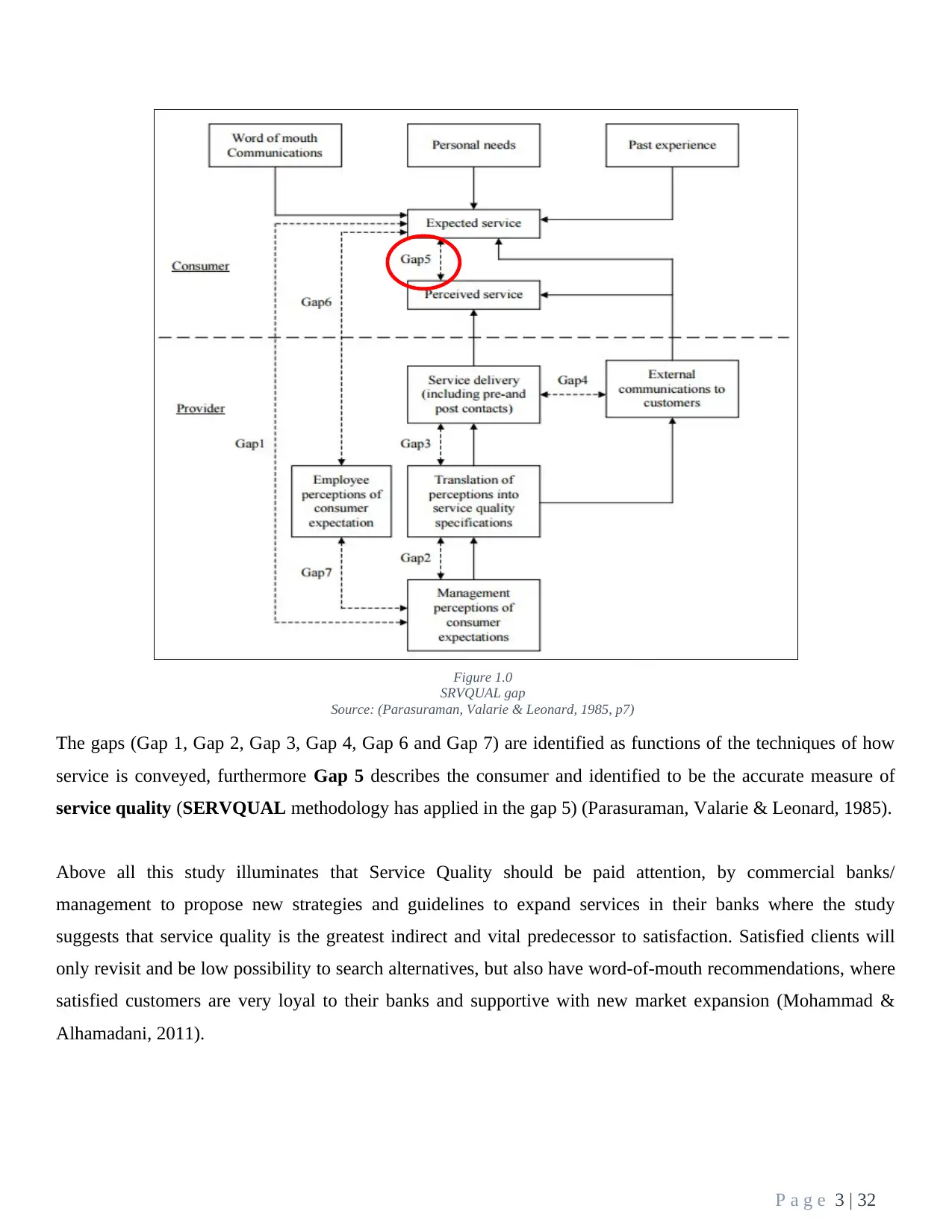
The gaps (Gap 1, Gap 2, Gap 3, Gap 4, Gap 6 and Gap 7) are identified as functions of the techniques of how
service is conveyed, furthermore Gap 5 describes the consumer and identified to be the accurate measure of
service quality (SERVQUAL methodology has applied in the gap 5) (Parasuraman, Valarie & Leonard, 1985).
Above all this study illuminates that Service Quality should be paid attention, by commercial banks/
management to propose new strategies and guidelines to expand services in their banks where the study
suggests that service quality is the greatest indirect and vital predecessor to satisfaction. Satisfied clients will
only revisit and be low possibility to search alternatives, but also have word-of-mouth recommendations, where
satisfied customers are very loyal to their banks and supportive with new market expansion (Mohammad &
Alhamadani, 2011).
P a g e 3 | 32
Figure 1.0
SRVQUAL gap
Source: (Parasuraman, Valarie & Leonard, 1985, p7)
service is conveyed, furthermore Gap 5 describes the consumer and identified to be the accurate measure of
service quality (SERVQUAL methodology has applied in the gap 5) (Parasuraman, Valarie & Leonard, 1985).
Above all this study illuminates that Service Quality should be paid attention, by commercial banks/
management to propose new strategies and guidelines to expand services in their banks where the study
suggests that service quality is the greatest indirect and vital predecessor to satisfaction. Satisfied clients will
only revisit and be low possibility to search alternatives, but also have word-of-mouth recommendations, where
satisfied customers are very loyal to their banks and supportive with new market expansion (Mohammad &
Alhamadani, 2011).
P a g e 3 | 32
Figure 1.0
SRVQUAL gap
Source: (Parasuraman, Valarie & Leonard, 1985, p7)
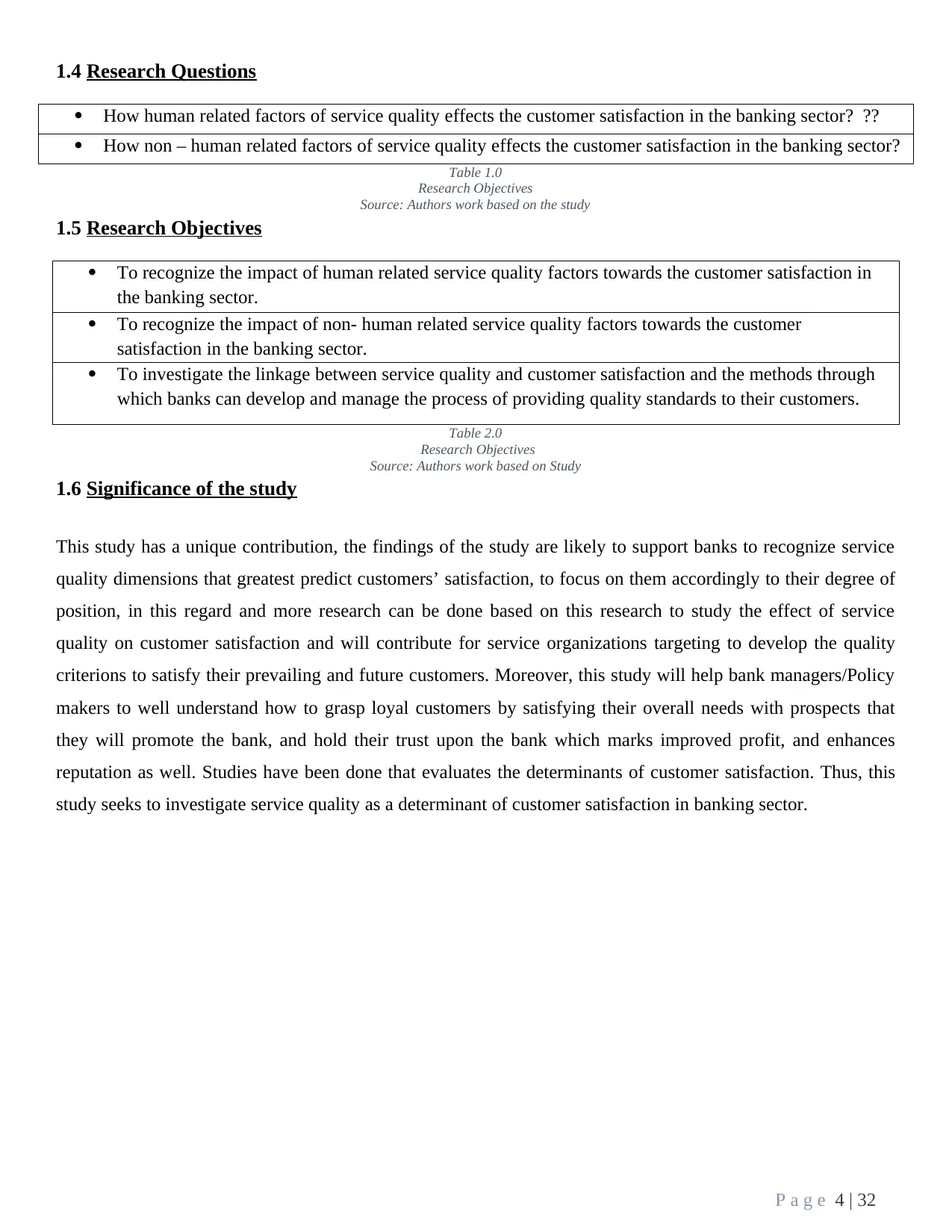
1.4 Research Questions
How human related factors of service quality effects the customer satisfaction in the banking sector? ??
bbbbajhfndddsbankiswswsssectorsector? How non – human related factors of service quality effects the customer satisfaction in the banking sector?
bankisesector? Table 1.0
Research Objectives
Source: Authors work based on the study
1.5 Research Objectives
To recognize the impact of human related service quality factors towards the customer satisfaction in
the banking sector.
To recognize the impact of non- human related service quality factors towards the customer
satisfaction in the banking sector.
To investigate the linkage between service quality and customer satisfaction and the methods through
which banks can develop and manage the process of providing quality standards to their customers.
Table 2.0
Research Objectives
Source: Authors work based on Study
1.6 Significance of the study
This study has a unique contribution, the findings of the study are likely to support banks to recognize service
quality dimensions that greatest predict customers’ satisfaction, to focus on them accordingly to their degree of
position, in this regard and more research can be done based on this research to study the effect of service
quality on customer satisfaction and will contribute for service organizations targeting to develop the quality
criterions to satisfy their prevailing and future customers. Moreover, this study will help bank managers/Policy
makers to well understand how to grasp loyal customers by satisfying their overall needs with prospects that
they will promote the bank, and hold their trust upon the bank which marks improved profit, and enhances
reputation as well. Studies have been done that evaluates the determinants of customer satisfaction. Thus, this
study seeks to investigate service quality as a determinant of customer satisfaction in banking sector.
P a g e 4 | 32
How human related factors of service quality effects the customer satisfaction in the banking sector? ??
bbbbajhfndddsbankiswswsssectorsector? How non – human related factors of service quality effects the customer satisfaction in the banking sector?
bankisesector? Table 1.0
Research Objectives
Source: Authors work based on the study
1.5 Research Objectives
To recognize the impact of human related service quality factors towards the customer satisfaction in
the banking sector.
To recognize the impact of non- human related service quality factors towards the customer
satisfaction in the banking sector.
To investigate the linkage between service quality and customer satisfaction and the methods through
which banks can develop and manage the process of providing quality standards to their customers.
Table 2.0
Research Objectives
Source: Authors work based on Study
1.6 Significance of the study
This study has a unique contribution, the findings of the study are likely to support banks to recognize service
quality dimensions that greatest predict customers’ satisfaction, to focus on them accordingly to their degree of
position, in this regard and more research can be done based on this research to study the effect of service
quality on customer satisfaction and will contribute for service organizations targeting to develop the quality
criterions to satisfy their prevailing and future customers. Moreover, this study will help bank managers/Policy
makers to well understand how to grasp loyal customers by satisfying their overall needs with prospects that
they will promote the bank, and hold their trust upon the bank which marks improved profit, and enhances
reputation as well. Studies have been done that evaluates the determinants of customer satisfaction. Thus, this
study seeks to investigate service quality as a determinant of customer satisfaction in banking sector.
P a g e 4 | 32
⊘ This is a preview!⊘
Do you want full access?
Subscribe today to unlock all pages.

Trusted by 1+ million students worldwide
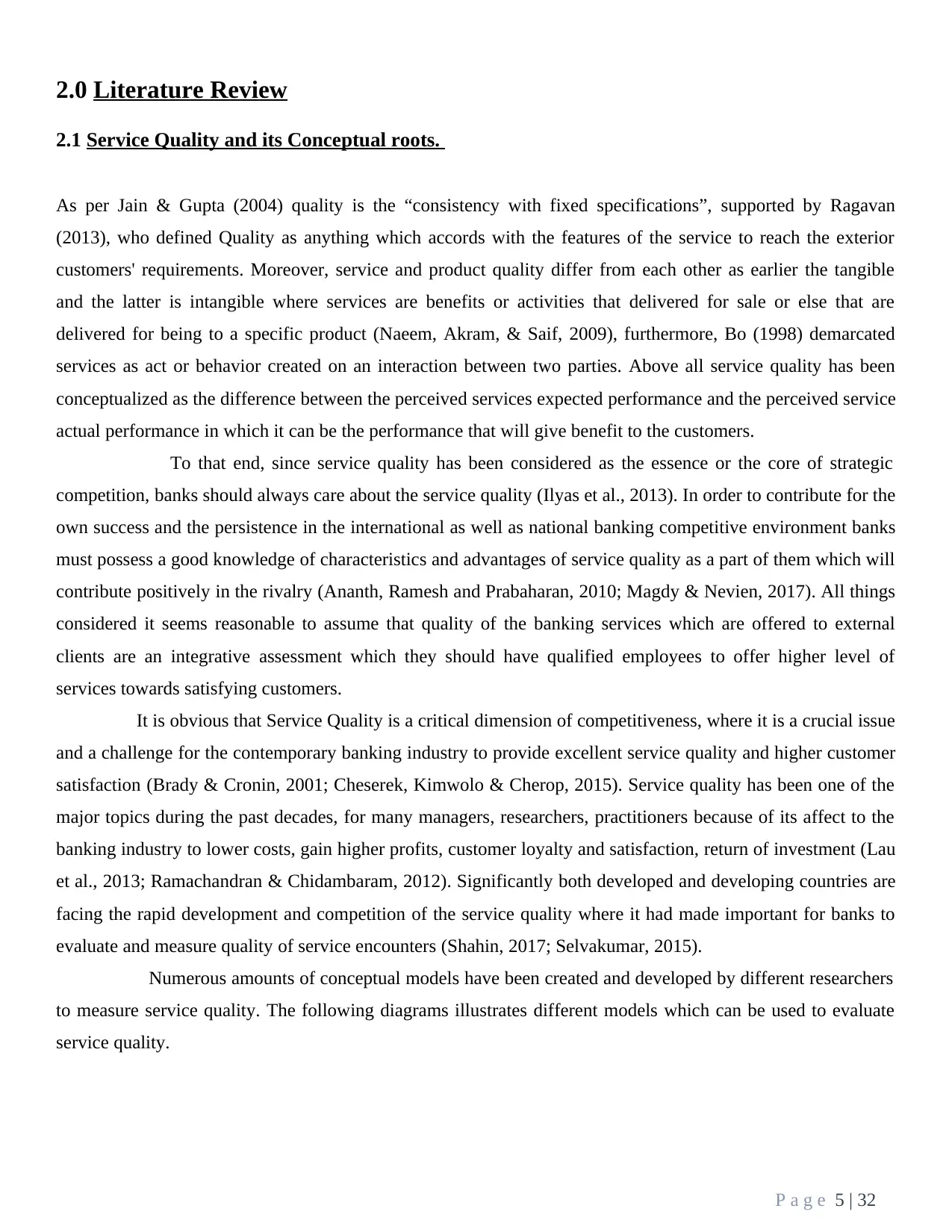
2.0 Literature Review
2.1 Service Quality and its Conceptual roots.
As per Jain & Gupta (2004) quality is the “consistency with fixed specifications”, supported by Ragavan
(2013), who defined Quality as anything which accords with the features of the service to reach the exterior
customers' requirements. Moreover, service and product quality differ from each other as earlier the tangible
and the latter is intangible where services are benefits or activities that delivered for sale or else that are
delivered for being to a specific product (Naeem, Akram, & Saif, 2009), furthermore, Bo (1998) demarcated
services as act or behavior created on an interaction between two parties. Above all service quality has been
conceptualized as the difference between the perceived services expected performance and the perceived service
actual performance in which it can be the performance that will give benefit to the customers.
To that end, since service quality has been considered as the essence or the core of strategic
competition, banks should always care about the service quality (Ilyas et al., 2013). In order to contribute for the
own success and the persistence in the international as well as national banking competitive environment banks
must possess a good knowledge of characteristics and advantages of service quality as a part of them which will
contribute positively in the rivalry (Ananth, Ramesh and Prabaharan, 2010; Magdy & Nevien, 2017). All things
considered it seems reasonable to assume that quality of the banking services which are offered to external
clients are an integrative assessment which they should have qualified employees to offer higher level of
services towards satisfying customers.
It is obvious that Service Quality is a critical dimension of competitiveness, where it is a crucial issue
and a challenge for the contemporary banking industry to provide excellent service quality and higher customer
satisfaction (Brady & Cronin, 2001; Cheserek, Kimwolo & Cherop, 2015). Service quality has been one of the
major topics during the past decades, for many managers, researchers, practitioners because of its affect to the
banking industry to lower costs, gain higher profits, customer loyalty and satisfaction, return of investment (Lau
et al., 2013; Ramachandran & Chidambaram, 2012). Significantly both developed and developing countries are
facing the rapid development and competition of the service quality where it had made important for banks to
evaluate and measure quality of service encounters (Shahin, 2017; Selvakumar, 2015).
Numerous amounts of conceptual models have been created and developed by different researchers
to measure service quality. The following diagrams illustrates different models which can be used to evaluate
service quality.
P a g e 5 | 32
2.1 Service Quality and its Conceptual roots.
As per Jain & Gupta (2004) quality is the “consistency with fixed specifications”, supported by Ragavan
(2013), who defined Quality as anything which accords with the features of the service to reach the exterior
customers' requirements. Moreover, service and product quality differ from each other as earlier the tangible
and the latter is intangible where services are benefits or activities that delivered for sale or else that are
delivered for being to a specific product (Naeem, Akram, & Saif, 2009), furthermore, Bo (1998) demarcated
services as act or behavior created on an interaction between two parties. Above all service quality has been
conceptualized as the difference between the perceived services expected performance and the perceived service
actual performance in which it can be the performance that will give benefit to the customers.
To that end, since service quality has been considered as the essence or the core of strategic
competition, banks should always care about the service quality (Ilyas et al., 2013). In order to contribute for the
own success and the persistence in the international as well as national banking competitive environment banks
must possess a good knowledge of characteristics and advantages of service quality as a part of them which will
contribute positively in the rivalry (Ananth, Ramesh and Prabaharan, 2010; Magdy & Nevien, 2017). All things
considered it seems reasonable to assume that quality of the banking services which are offered to external
clients are an integrative assessment which they should have qualified employees to offer higher level of
services towards satisfying customers.
It is obvious that Service Quality is a critical dimension of competitiveness, where it is a crucial issue
and a challenge for the contemporary banking industry to provide excellent service quality and higher customer
satisfaction (Brady & Cronin, 2001; Cheserek, Kimwolo & Cherop, 2015). Service quality has been one of the
major topics during the past decades, for many managers, researchers, practitioners because of its affect to the
banking industry to lower costs, gain higher profits, customer loyalty and satisfaction, return of investment (Lau
et al., 2013; Ramachandran & Chidambaram, 2012). Significantly both developed and developing countries are
facing the rapid development and competition of the service quality where it had made important for banks to
evaluate and measure quality of service encounters (Shahin, 2017; Selvakumar, 2015).
Numerous amounts of conceptual models have been created and developed by different researchers
to measure service quality. The following diagrams illustrates different models which can be used to evaluate
service quality.
P a g e 5 | 32
Paraphrase This Document
Need a fresh take? Get an instant paraphrase of this document with our AI Paraphraser
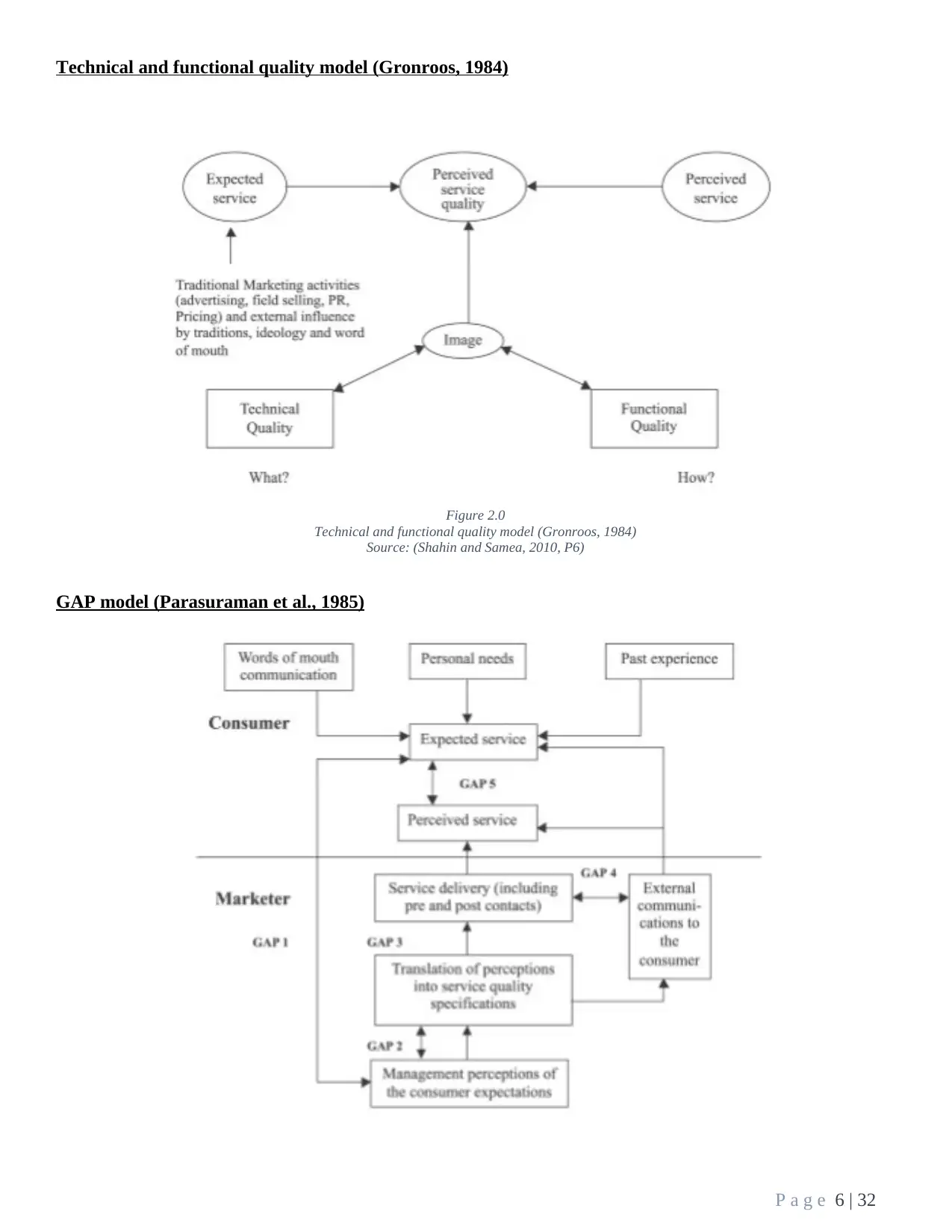
Technical and functional quality model (Gronroos, 1984)
GAP model (Parasuraman et al., 1985)
P a g e 6 | 32
Figure 2.0
Technical and functional quality model (Gronroos, 1984)
Source: (Shahin and Samea, 2010, P6)
GAP model (Parasuraman et al., 1985)
P a g e 6 | 32
Figure 2.0
Technical and functional quality model (Gronroos, 1984)
Source: (Shahin and Samea, 2010, P6)
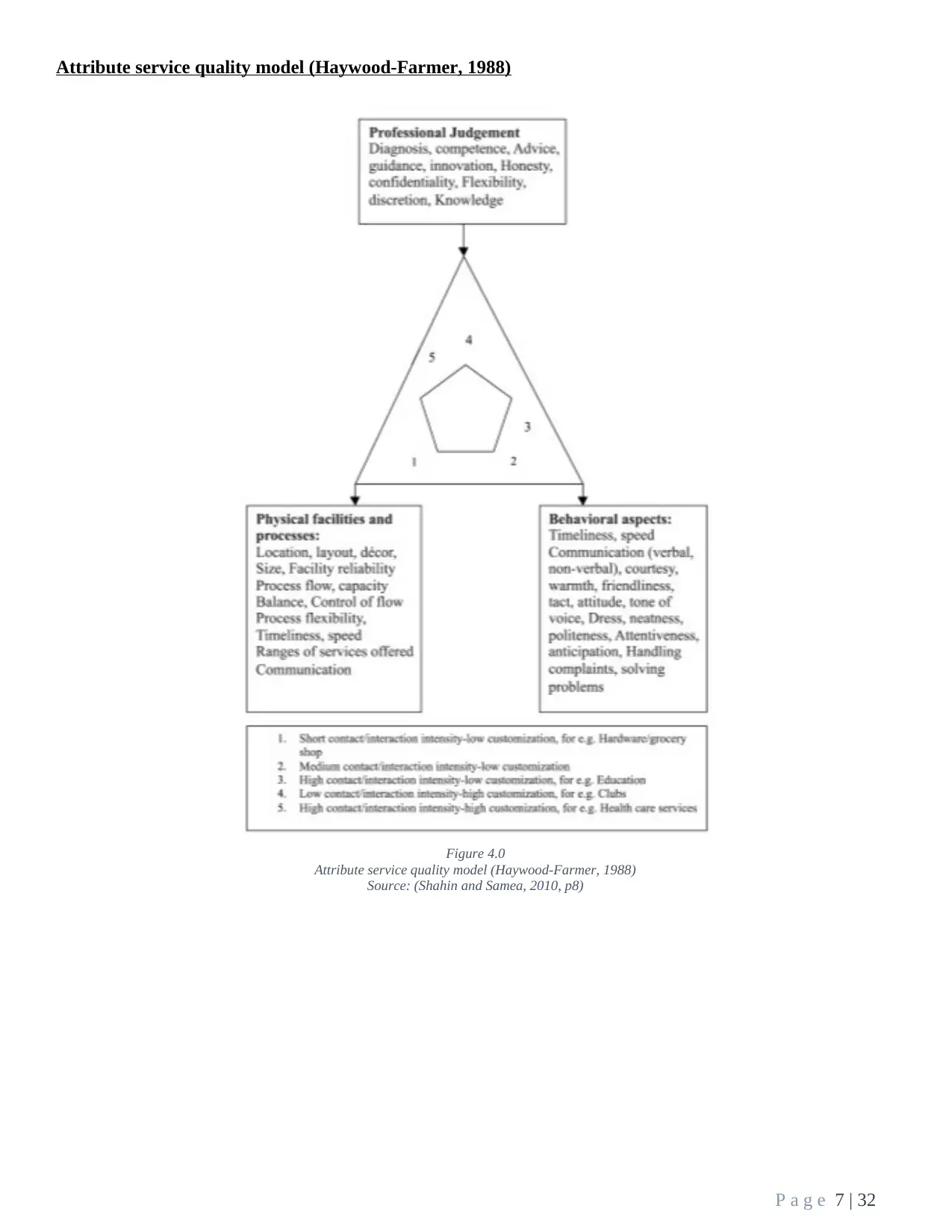
Attribute service quality model (Haywood-Farmer, 1988)
P a g e 7 | 32
Figure 4.0
Attribute service quality model (Haywood-Farmer, 1988)
Source: (Shahin and Samea, 2010, p8)
P a g e 7 | 32
Figure 4.0
Attribute service quality model (Haywood-Farmer, 1988)
Source: (Shahin and Samea, 2010, p8)
⊘ This is a preview!⊘
Do you want full access?
Subscribe today to unlock all pages.

Trusted by 1+ million students worldwide
1 out of 31
Related Documents
Your All-in-One AI-Powered Toolkit for Academic Success.
+13062052269
info@desklib.com
Available 24*7 on WhatsApp / Email
![[object Object]](/_next/static/media/star-bottom.7253800d.svg)
Unlock your academic potential
Copyright © 2020–2025 A2Z Services. All Rights Reserved. Developed and managed by ZUCOL.




